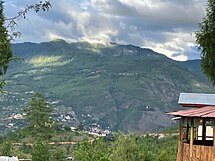Benutzer:Shi Annan/Rinpung Dzong
Vorlage:Short description Vorlage:For Vorlage:Use dmy dates Vorlage:Infobox Tibetan Buddhist monastery

Rinpung Dzong, sometimes referred to as Paro Dzong, is a large dzong - Buddhist monastery and fortress - of the Drukpa Lineage of the Kagyu school in Paro District, Bhutan. It houses the district Monastic Body as well as government administrative offices of Paro Dzongkhag. It is listed as a tentative site in Bhutan's Tentative List for UNESCO inclusion.
History[Bearbeiten | Quelltext bearbeiten]
In the 15th century local people offered the crag of Hungrel at Paro to Lama Drung Drung Gyal, a descendant of Pajo Drugom Zhigpo. Drung Drung Gyal built a small temple there and later a five storied Dzong or fortress which was known as Hungrel Dzong.[1]
In the 17th century, his descendants, the lords of Hungrel, offered this fortress to the Drukpa hierarch, Ngawang Namgyal, the Zhabdrung Rinpoche, in recognition of his religious and temporal authority. In 1644 the Zhabdrung dismantled the existing dzong and laid the foundations of a new dzong.[2] In 1646 the dzong was reconsecrated and established as the administrative and monastic centre of the western region and it became known as "Rinpung Dzong".[3] During the reign of the 23rd Penlop Dawa Penjor the Fortress caught fire (before the first king Gongsa Ugyen Wangchuck was enthroned)[4] and all the important relics and statues were burnt, except for the Thongdrel (20x20 metre-wide).[5]Paying homage to the Thongdrel it is believed that the faithful can attain Nirvana.[6]
Some scenes in the 1993 film Little Buddha were filmed in this dzong.Vorlage:Citation needed .According to the history of Paro Dzong, written by Drungchen Dasho Sangay Dorji, the rock face below the dzong was named 'Ringpung' by Guru Rinpoche in the eighth century, hence when the dzong was later built here, it came to be known as 'Ringpung Dzong'.[7]
Shrines and chapels[Bearbeiten | Quelltext bearbeiten]

Inside Rinpung Dzong are fourteen shrines and chapels:
- Kungarwa
- Monks' assembly hall
- Sandalwood Stupa
- Protector's shrine
- Temple of the Guru's Eight Manifistations (Vorlage:Lang-dz)
- Chapel of the head lama
- Chapel of Amitayus
- The Clear Crystal Shrine
- Chapel of the Eleven-faced Avalokiteśvara
- Apartments of the Abbot
- Chapel of Akshobhya
- Temple of the Treasure Revealer
- Apartments of the King (Gyalpo'i Zimchung)
- Temple of the Bursar
Outside the main dzong is the Deyangkha Temple.
On the hill above Rinpung Dzong is a seven-storied the watchtower fortress or Ta Dzong built in 1649. In 1968 this was established as the home of the National Museum of Bhutan.
Just below Rinpung Dzong is a traditional covered cantilever bridge.
Festival[Bearbeiten | Quelltext bearbeiten]
A great annual festival or tshechu is held at Rinpung Dzong from the eleventh to the fifteenth day of the second month of the traditional Bhutanese lunar calendar (usually in March or April of the Gregorian calendar). On this occasion, holy images are taken in a procession. This is followed by a series of traditional mask dances conveying religious stories which are performed by monks for several days.
Before the break of dawn on the morning of the fifteenth day, a great sacred thongdrel banner thangka depicting the Eight Manifestations of Padmasambhava, (Guru Pema Jungney, Guru Nima Yoezer, Guru singye dradrong, Guru tshoki Dorji, Guru shacha singye, Guru pema gyelpo, Guru dorji dolo, and Guru lodan Chokse)[4] is displayed for the public in the early morning hours, to keep to the tradition of not allowing sunlight to fall on it.[8][9][10] The ground on which the monks perform the mask dance is called Deyangkha.[11]
References[Bearbeiten | Quelltext bearbeiten]
- ↑ Lopon Kunzang Thinley (2008) p.4
- ↑ Dasho Sangay Dorji (2008) p.166
- ↑ Lopon Kunzang Thinley (2008) p.5
- ↑ a b Phun-tshogs-bkra-shis, Mkhan-po Phun-tshogs-bkra-śis: Invoking happiness: guide to the sacred festivals of Bhutan & Gross National Happiness. 1. publ Auflage. Khenpo Phuntshok Tashi, Thimphu 2011, ISBN 978-99936-777-3-4.
- ↑ Bstan-vdzin-rnam-rgyal (Hrsg.): Dzongs of Bhutan: fortresses of the Dragon kingdom. 2. Auflage. Bhutan Times, Thimphu 2008, ISBN 978-99936-705-2-0.
- ↑ Mary Varnham: Bhutan Himalayan Kingdom. The Royal Government of the kingdom of the Bhutan, USA 1979, S. 44.
- ↑ Seeds of faith. 1. KMT Publ, Thimphu 2008, ISBN 978-99936-22-42-0.
- ↑ John A. Ardussi: Gyalse Tenzin Rabgye and the Founding of Taktsang Lhakhang. In: Journal of Bhutan Studies. 1. Jahrgang, Nr. 1. Centre for Bhutan Studies, Thimphu 1999, S. 28 (cam.ac.uk [PDF; abgerufen am 12. März 2010]).
- ↑ The Paro Tsechu. Abgerufen am 7. März 2010.
- ↑ The Paro Tsechu – the Thondrol of Guru Rincpoche. Abgerufen am 7. März 2010.
- ↑ Phun-tshogs-bkra-shis, Mkhan-po Phun-tshogs-bkra-śis: Invoking happiness: guide to the sacred festivals of Bhutan & Gross National Happiness. 1. publ Auflage. Khenpo Phuntshok Tashi, Thimphu 2011, ISBN 978-99936-777-3-4.
Sources[Bearbeiten | Quelltext bearbeiten]
- Sangay (Dasho) Dorji, Kinga, Sonam (trans.): The Biography of Zhabdrung Ngawang Namgyal: Pal Drukpa Rinpoche. KMT Publications, Thimphu, Bhutan 2008, ISBN 99936-22-40-0.
- Lopon Kunzang Thinley, KMT Research Group: Seeds of Faith: A Comprehensive Guide to the Sacred Places of Bhutan. Volume 1. KMT Publications, Thimphu 2008, ISBN 99936-22-41-9.
External links[Bearbeiten | Quelltext bearbeiten]
Vorlage:Buddhist monasteries in Bhutan [[Category:Dzongs in Bhutan]] [[Category:Buddhist monasteries in Bhutan]] [[Category:Tibetan Buddhism in Bhutan]]